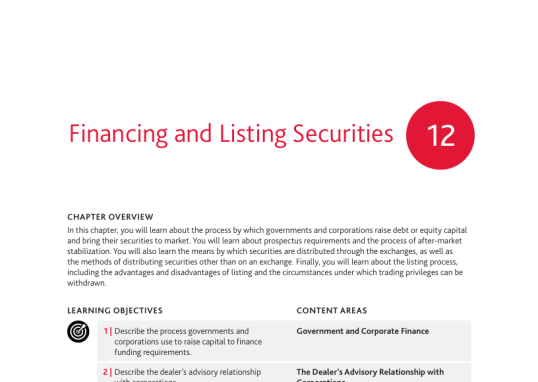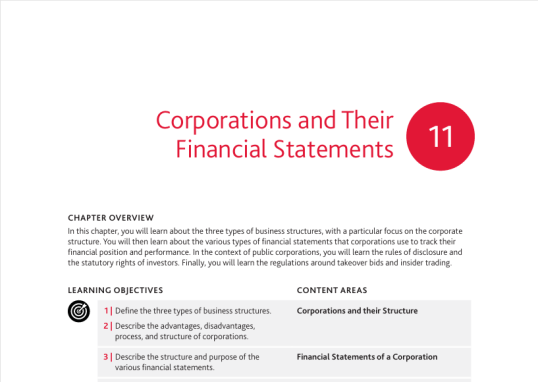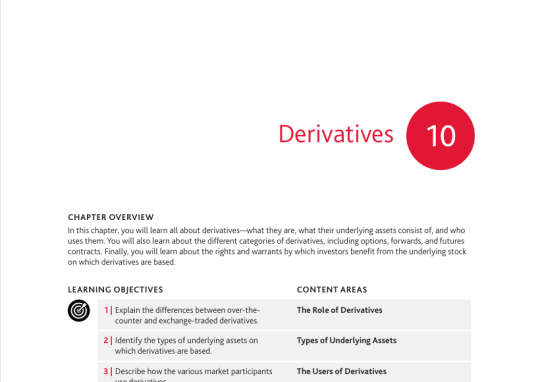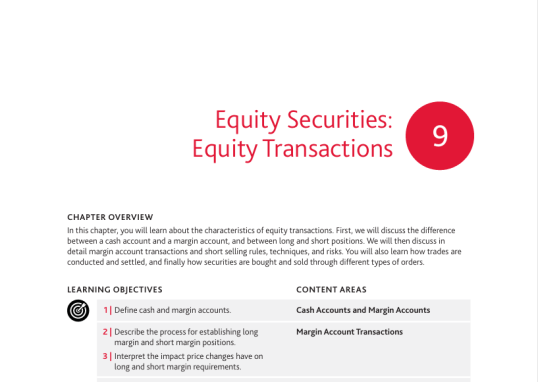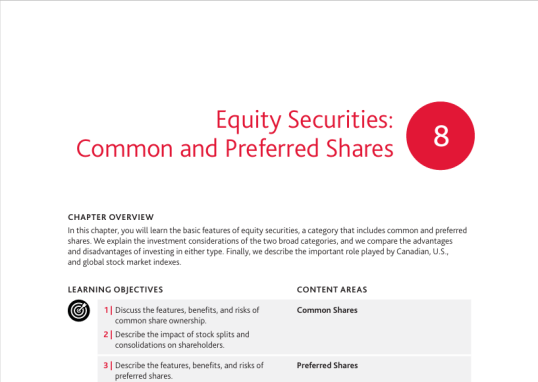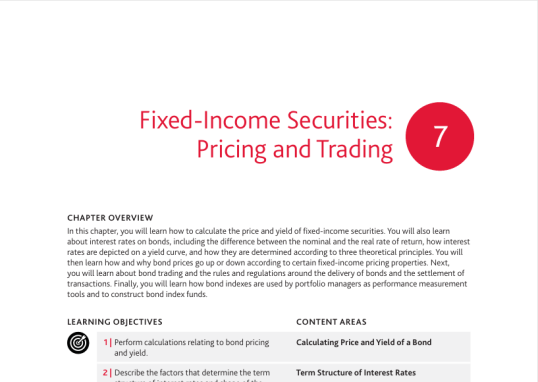CSC V.1 Chapter6 notes
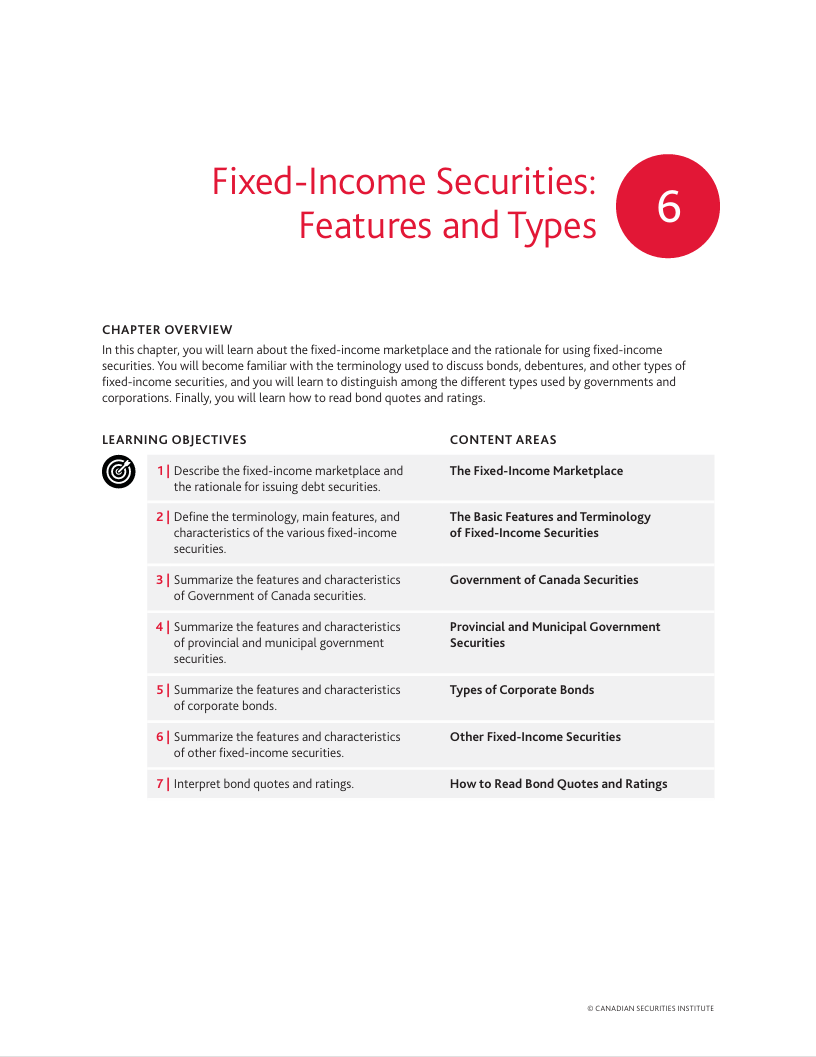
FIXED INCOME SECURITIES: FEATURES AND TYPES
THE FIXED-INCOME MARKETPLACE
- Companies issue bonds to take advantage of their “leverage” potential. This means that they hope to borrow money at 6% and reinvest it in their operations and make 10% – and keep the spread as a reward for the company owners/shareholders
- Governments issue bonds when they are running deficits: Spending exceeds revenue and there is a shortfall that must be financed
- Details of a bond issue are outlined in a trust deed and written into a bond contract
- A bond is secured by physical assets. A debenture is secured by “something other than a physical asset” – which means the residual assets of the company. It is equally legally binding to pay interest and principal on both bonds and debentures
BASIC FEATURES OF A BOND
Most bonds/debentures pay interest semi-annually or twice a year. This means that a bond with a 5% coupon rate or interest rate actually pays 2.5% every six months. Coupon payments are based on the face, par value or maturity amount of the bond. These payments do not change if and when the market value of the bond/debenture changes
- Consider the cash flows of a two-year “straight bond” (which means no special features) with a face value of $1,000,000 and a coupon of 4% that was issued on May 1st, 2021:
- May 1st 2021, issuing company would receive $1,000,000
- Nov 1st 2021, issuing company would pay $20,000
- May 1st 2022, issuing company would pay $20,000
- Nov 1st 2022, issuing company would pay $20,000
- May 1st 2023, issuing company would pay $1,020,000
BOND TERMINOLOGY
- Par Value – also called face value, this is the principal amount the bond issuer contracts to pay at maturity
- Coupon rate – this is the interest rate paid by the bond issuer relative to the bond’s par value
- Maturity date – date at which the bond matures, which is when the principal is paid back
- Term to maturity – time that remains before a bond matures
- Bond price – present discount value of all the future payments
- Yield to maturity – annual return on the bond that is held to maturity
BOND FEATURES
- Interest payments can take the following forms: Coupon rates can change over time, as with step-up bonds; Interest can be compounded over time and paid at maturity, as with zero-coupon bonds; and a rate of interest does not have to be applied but the return can be based on a future factor, such as the change in the level of the index
- Denominations – bonds can be purchased only in specific denominations
- Bond pricing – a bond trading below par (98) is trading at a discount while a bond trading above par (104) is trading at a premium. “98” means 98% of the par value, while “104” means 104% of the par value
TERM TO MATURITY
- The term to maturity of a bond is determined from the present to its maturity date. Therefore, if a bond had been issued four years ago for a ten year term, this would be understood as a bond with six years to maturity
- Bonds with one year or less until maturity are considered Money Market instruments
- Bonds with one to five years to maturity are short-term
- Bonds with five to ten years to maturity are medium term
- Bonds with greater than ten years are long-term
EXAMPLE: “A bond was issued in the Year 2010 that would mature in 2025. In the year 2021, this would be understood as a medium-term bond.” The fact that it was originally issued as a long-term bond is irrelevant
- Bonds that trade on the secondary market can be understood as being liquid, negotiable, or marketable
- Liquid bonds trade in significant volumes and can be traded without making a significant sacrifice in price
- Negotiable bonds can be transferred because they are in deliverable form
- Marketable bonds have a ready market because their price and features are attractive – however, they may not be liquid
STRIP BONDS
- Strip bonds or zero coupon bonds are created when a dealer acquires a block of high-quality bonds and separates the coupon payments and principal, and sells each separately at a discount. The amount of discount determines the annualized rate of return the investor will enjoy
BOND FEATURES
- Callable or redeemable feature gives the issuer the right to call or redeem the debt before its stated maturity. Generally, this feature is exercised if interest rates have decreased since the bond was issued
- Standard call features – the call price is usually set higher than the par value of the bond. Provincial bonds are usually callable at 100 plus accrued interest. The period before the first possible call date is the call protection period
- Extendible bonds allow the investor the option to extend the maturity at the same or a slightly higher rate of interest
- Retractable bonds allow the investor the option to receive principal back prior to the stated maturity date
CONVERTIBLE BONDS
- Convertible bonds provide the investor the option of receiving common shares instead of principal. This is why they are called “convertible” – the investor has the choice of converting a debt investment into an equity investment. The right to exchange a bond for common shares is called the conversion privilege
EXAMPLE: “A $1,000 face value convertible bond pays 4% interest and is convertible into 50 common shares.” In this case, the decision to convert would be driven by the common share price. If it exceeded $20 per share, it would be attractive to convert – because 50 x $20 = $1,000… the break-even price
- Convertible shares are issued by companies to help reduce their borrowing costs. Convertible shares are purchased by investors because they are a “two-way” security… there’s the security of debt with the potential for significant capital appreciation
- The conversion price of most convertible bonds goes up gradually over time
- Forced conversion is a feature built into convertible bonds where the company can force the investor to convert the bonds into common shares, if the share price exceeds a stipulated level
- When the common share price exceeds the break-even conversion price, the convertible bonds are said to be “selling off the stock”. In our example: If the common shares are $25, then the convertible bond will be worth at least $1,250 (50 x $25)
SINKING FUNDS AND PURCHASE FUNDS
- Sinking funds and purchase funds mean that the issuer may repay portions of their bonds before maturity
- Sinking fund provisions are sums of money set aside to retire debt at stipulated prices and are as binding on the issuer as any mortgage provision
- Purchase fund provisions kick in if the bonds fall below a certain market price – purchase funds are intended to act as a price support. Purchase funds generally retire less of an issue than a sinking fund
PROTECTIVE PROVISIONS
- These are safeguards provided to bond investors to help protect their payments of interest and principal
- Security means that details of the assets that support the debt are provided (e.g., mortgage-backed or asset backed securities)
- Negative pledge means that the borrower will not pledge any assets if the pledge results in less security for the debt holder
- Limitation on Sale and Leaseback protects the debt holder against the firm selling and leasing back assets that provide security for the debt
- Sale of Assets or Merger means that in the event that all of the firm’s assets are sold or the company is merged with another company, the debt must be retired or assumed by the new merged company
- Dividend Test establishes the rules for the payment of dividends by the firm
- Debt Test limits the amount of additional debt that a firm may issue by establishing a maximum debt-to asset ratio
- Additional Bond Provisions state which financial tests and other circumstances allow the firm to issue additional debt
- Sinking or Purchase Fund and Call Provisions outline the provisions of the sinking or purchase fund, and the specific dates and price at which the firm can call the debt
FEDERAL GOVERNMENT SECURITIES
- The Government of Canada issues a variety of fixed-income securities
- Marketable bonds – largest single issuer in the Canadian marketplace. All GOC bonds are noncallable
- Treasury bills – short-term government obligations, offered in denominations from $1,000 to $1,000,000. These are auctioned every two weeks by the Minister of Finance through the Bank of Canada with original terms to maturity of 3 months, 6 months and 1 year. T bills are issued at a discount and mature at 100. The difference between the issue price and maturity value is taxable as interest income; however we do not consider T-bills as interest-paying instruments
- Canada Savings Bonds (CSBs) and Canada Premium Bonds – were a secure savings product; however due to declining sales, the sale was discontinued in November 2017. These bonds are not transferable, therefore have no secondary market. The bonds can be redeemed by investors at any time throughout the year
- Real return bonds – the coupon payments and principal repayment are adjusted for inflation to provide a fixed real coupon rate. At each interest payment, the real coupon is applied to a principal balance that has been adjusted for the cumulative level of inflation
PROVINCIAL AND MUNICIPAL SECURITIES
- Provincial bonds are second in quality only to Government of Canada direct and guaranteed bonds
- Provinces offer direct bonds and guarantee the bonds of provincially appointed authorities and commissions. Guaranteed bonds are as secure as direct bonds
- Some provinces issues their own savings bonds. They can be purchased only by residents of the province, can only be purchased at a certain time of the year, and they are redeemable every six months
- Municipal (city) governments use instalment debentures or serial bonds. With these bonds, a portion of the principal amount is paid annually – a ten year debenture issue with a face value of $10,000,000 would be structured such that $1,000,000 is retired at the end of each year
CORPORATE BONDS
- Mortgages or mortgage bonds are loans secured by a pledge of land, buildings or equipment. These are very secure borrowings. First mortgage bonds are the senior securities of a company
- Floating-rate securities automatically adjust their payments based on an underlying agreed upon formula
DOMESTIC, FOREIGN AND EUROBONDS
- Domestic bonds are issued in the currency and country of the issuer. Foreign bonds are issued in a currency and country other than the issuer. Foreign pay bonds are issued in a currency other than the issuer’s currency, but sold in the issuer’s country. Eurobonds are issued and sold outside a domestic market and are typically denominated in a currency other than that of the domestic market
| Issuer | Issued in | Currency of issue | Called |
| Canadian | Canada | CAD | Domestic bond |
| Canadian | Mexico | MXN | Foreign bond |
| Canadian | France | USD | Eurobond (Eurodollar) |
| Canadian | European Market | CAD | Eurobond (EuroCanadian) |
| Canadian | United States | USD | Foreign (Yankee) bond |
OTHER TYPES OF CORPORATE DEBT
- Collateral trust bonds are loans secured by a pledge of securities – such as common shares. Collateral trust bonds are issued by holding companies
- Equipment trust certificates are loans secured by real property – such as transportation companies like CP Locomotives
- Subordinated debentures are junior to other securities or other debts – they are the riskiest kind of debt; therefore provide the highest return
- Corporate notes are unsecured promises to pay interest and are junior to all other fixed-interest securities of the borrower. Finance companies frequently use a type called a secured note or collateral trust note
- High-yield bonds are considered non-investment grade. They have higher risk; therefore these bonds typically pay higher coupons and have higher yields
OTHER FIXED-INCOME SECURITIES
- Bankers’ Acceptances are commercial drafts drawn by a borrower for payment on a specific date. They are guaranteed at maturity by the borrower’s bank
- Commercial Paper is an unsecured promissory note issued by a corporation or an asset-backed security backed by a pool of underlying financial assets
- Term Deposits offer a guaranteed rate for a short-term deposit (usually up to one year) with penalties for early withdrawal (the first 30 days after purchase)
- Guaranteed Investment Certificates (GICs) offer fixed rates of interest and have a variety of special features:
- Escalating rate GICs – the interest rate increases each year
- Laddered GICs – the investment is equally divided into multiple term lengths to reduce interest rate risk
- Instalment GICs – an initial lump sum contribution is followed by weekly, bi-weekly or monthly additions
- Index-linked GICs – the return is linked to an underlying equity market such as the TSX or S&P 500
- Interest-rate-linked GICs – offer returns linked to other interest rates, such as prime or money market rates
FIXED-INCOME MUTUAL FUNDS AND EXCHANGE-TRADED FUNDS
- These managed products provide investors with easy access to a diversified portfolio of debt
- These products are particularly attractive for investors who have a limited amount of money to invest or who find investing in individual bonds too complex
READING A BOND QUOTE
| Issue | Coupon | Maturity | Bid | Ask | Yield |
| ABC Company | 11.5% | July 1/28 | 99.25 | 99.75 | 11.78% |
- This bond was issued by ABC Company. From the bond quote, we cannot determine the date of issue
- The coupon rate of 11.5% is based on the par value of the bond
- The maturity date establishes when the principal amount will be returned to the investor
- The “bid” price of 99.25 means that if an investor had $1,000 face value, it could be sold for $992.50 plus accrued interest
- The “ask” price of 99.75 means that if an investor wanted to purchase $1,000 face value, it would cost $997.50 plus accrued interest
- Because the bond is trading at a discount, the yield is higher than the coupon. The yield of 11.78% implies that this would be the investor’s effective return when both coupon payments and capital gains are factored in
BOND RATING SERVICES
- In Canada, the DBRS, Moody’s Canada and Standard & Poor’s Bond Rating Service provide independent ratings for debt securities. The following ratings categories are used by Moody’s:
- “Aaa” rating implies the highest quality of bond, subject to the lowest level of credit risk
- “Baa” rating implies that these are medium-grade and subject to moderate credit risk
- “Caa” rating implies speculative quality, of poor standing, and are subject to very high credit risk
Author
shanghaizhangyijie@gmail.com
